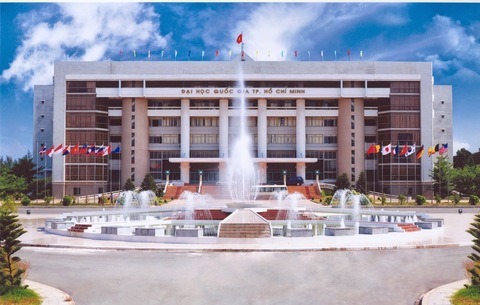
Viet Nam National University HCM City. — Photo courtesy of VNUHCM
As a pioneer and key pillar in Viet Nam’s education system, Viet Nam National University-HCM City (VNUHCM) is developing sustainably and affirmed its position as a well-known national multi-disciplinary training and scientific research centre in Southeast Asia for more than 23 years.
VNUHCM has pioneered many latest models and technologies in training, contributing to the country’s socio-economic development and higher education reform.
In 2010 VNUHCM became the first university in the country to adopt an innovative educational framework titled CDIO (Conceiving — Designing — Implementing — Operating) designed to produce the next generation of engineers and help improve the quality of most of its curriculums in many other majors besides engineering to train skilled human resources who can adapt to the fourth industrial revolution.
VNUHCM now has five member universities with 30 departments and 62 majors adopting the CDIO framework.
Thanks to the CDIO framework, it had the largest number of modern and comprehensive training programmes to meet global standards in the country as of June this year.
VNUHCM has 45 training programmes accredited by the ASEAN University Network-Quality Assurance (AUN-QA), which is the ASEAN quality assurance network in higher education. AUN-QA has a responsibility to promote quality assurance in higher education institutions, raise the quality of higher education and collaborate with both regional and international bodies for the benefit of the ASEAN community.
Its seven high-quality Viet Nam-Germany training programmes meet the standards of Commission des Titres d’Ingénieur while two others are accredited by the American Accreditation Board for Engineering and Technology (ABET).
In December VNUHCM will have three more training programmes audited by ABET.
It has guided many other universities nationwide, including the Viet Nam National University- Ha Noi, Ha Noi University of Science and Technology, Vinh University in Nghe An Province, and others, in adopting the CDIO framework.
Strengthening research
As of now the university has set up and expanded relationships with other universities in the U.S., Australia, New Zealand, Ireland, Belgium, Portugal, Netherlands and several countries in Asia to carry out joint training and research programmes which focus on hi-tech agriculture, climate change, smart city, and artificial intelligence.
VNUHCM has set up a network of 60 modern labs for scientific research and technology training and transfer.
Moreover, it has set up 41 teams of outstanding researchers in social sciences and humanity, economics, law, management, natural sciences, earth sciences and environment, and IT.
It has published and made more than 4,500 articles and conference presentations in many different fields each year in the last three years.
In fact, the scientific magazines Biomedical Research and Therapy and Progress in Stem Cell published by its Institute of Stem Cells are named in the catalogue of Scopus, the largest abstract and citation database of peer-reviewed literature like scientific journals, books and conference proceedings.

Research at Institute for Nanotechnology. — Photo courtesy of VNUHCM
The number of articles it has published in magazines in the Institute for Scientific Information (ISI)’s list accounts for nearly 10 per cent of the university’s total published articles in foreign magazines.
VNUHCM’s strategic objective is to serve the country’s socio-economic development, especially in the southern region.
Many technologies resulting from research in the fields of integrated circuits, new materials and bio-technology have been transferred to enterprises and organisations in the country.
Revenues from such transfer were worth more than VND81 billion (US$3.5 million) in the first six months of this year.
The university has also done a lot of research into improving living condition and training human resources for the Mekong Delta region. With the establishment of its campus in Ben Tre province, it has created favorable conditions to improve the quality of human resources in the region.
It has tied up with the Viet Nam Academy of Social Sciences for a programme on sustainable development of science and technology in the south-western region to solve major problems in the Mekong Delta.
In April this year its Institute for Nanotechnology presented Vinh Long and Ben Tre provinces an automatic monitoring and warning system for salt intrusion.
Enhancing start-ups and innovation
This issue is an important part of the university’s strategy. It focuses on nurturing innovative start-ups in the IT field and helping them develop through new business models.
It is strengthening collaboration with the private sector and relevant public organizations in the country to bring vital resources to start-up businesses to spur them on to success.
Several promising start-ups have been set up in its Information Technology Park, including MimosaTek, MagikLab and Gcall Viet Nam, which received a million–dollar investment from Vina Capital through the reality television show Shark Tank Vietnam.
In 2017, with funds allocated by the city People’s Committee through the Department of Information and Communication, the university launched a start-up enhancing programme titled iStartX, which trained people wanting to start businesses.
During this time five more start-ups began operations at the Information Technology Park.
VNUHCM was established in January 1995 as a centre for multi-disciplinary and high-quality higher education, postgraduate training and scientific research.
It now has six universities - University of Technology, University of Science, University of Social Sciences and Humanities, International University, University of Information Technology, and University of Economics and Law - Institute for Environment and Resources, School of Medicine, and 27 affiliated units for training, scientific research and technology transfer.
It has more than 6,000 employees, including 369 professors, 1,250 doctorates and 3,500 lecturers with master’s degrees, training more than 60,000undergraduate students and more than 8,500 graduate students.